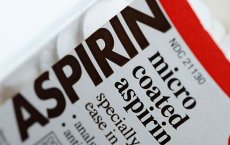Medical expert of the article
New publications
Allergy to Aspirin
Last reviewed: 23.04.2024

All iLive content is medically reviewed or fact checked to ensure as much factual accuracy as possible.
We have strict sourcing guidelines and only link to reputable media sites, academic research institutions and, whenever possible, medically peer reviewed studies. Note that the numbers in parentheses ([1], [2], etc.) are clickable links to these studies.
If you feel that any of our content is inaccurate, out-of-date, or otherwise questionable, please select it and press Ctrl + Enter.

Acetylsalicylic acid, also called aspirin, is referred to as such drugs, which are ubiquitous and for a long time used in diseases characterized by inflammation and pain syndromes.
To date, it is known that aspirin leads to bronchial asthma (it becomes its cause in 10% of cases); urticaria (0.3% probability), with chronic urticaria in 23% of cases develop relapse.

Allergy to aspirin also develops in patients who have: atopy, female, if an HQA2 antigen is observed in the HLA phenotype and the frequency of the HLA antigen DPBI 0401 is reduced.
Signs of an allergy to aspirin
Clinical manifestations of allergy to aspirin are considered to be the following symptoms:
- the presence of anaphylactoid reactions, which can be caused by such drugs as zomepirac, tolmetin, diclofenac;
- the presence of rhinoconjunctivitis and bronchial asthma - with chronic eosinophilic rhinosinusitis, when there is some nasal polyps present or not, and if there is a secondary purulent infection; with asthma, most often severe and cortex-dependent. A classic triad is the presence of rhinitis accompanied by nasal polyps, bronchial asthma and sensitivity to aspirin;
- the presence of skin manifestations - chronic urticaria, angioedema, isolated periorbital edema, Lyell's syndrome (with fenbrofen, indomethacin, piroxicam); purpura (with phenylbutazone, salicylates); photodermatitis (with naproxen, piroxicam, tiaprofenic acid, benoxaprofen);
- presence of hematological manifestations - eosinophilia, cytopenia;
- with respiratory manifestations - pneumonitis (with fever, cough, pulmonary infiltrates). It is observed when the patient is sick with arthritis (different types of it) and usually when using naproxen, sulindac, ibuprofen, azaprozone, indomethacin, piroxicam, phenylbutazone, oxyphenylbutazone, diclofenac.
The clinical plan is described by a new triad: atopy, sensitivity to anti-inflammatory drugs of the non-steroid class, development of anfilaxia, if the influence is exerted by house dust (the effect of the aeroallergen).
Symptomatology of the respiratory system with allergy to aspirin:
- presence of suffocation;
- presence of asthmatic attacks;
- presence of shortness of breath;
- wheezing.
- tingling in the lungs.
Symptomatic of the digestive system with allergy to aspirin:
- The gastrointestinal tract works with malfunctions;
- periodic or persistent indigestion;
- excrement becomes light color;
- presence of colic in the navel;
- the patient has heartburn;
- dryness and bitterness in the oral cavity;
- unintended eructations.
- increase in the threshold of the emetic reflex;
Symptomatic of the nervous system with allergy to aspirin:
- the patient suffers from headaches, up to migraines;
- blood pressure rises;
- the occipital part of the head is numb;
- the patient is dizzy;
- the appearance of a whistle in the ears;
- general fatigue;
- apathy;
- body temperature rises;
- the color of the skin changes;
- On the patient's body appear red spots, on the circumference they are slightly flaky;
- the primary stage of hives.
Diagnosis of allergy to aspirin
When specialists tried to detect allergy to aspirin, using skin testing, this method was ineffective (IgE-antibodies on platelet antigens, salicylol and O-methyl salicyloyl influenced).
In order to qualitatively diagnose hypersensitivity to aspirin, as well as preparations against inflammation of the nonsteroid group, the use of a controlled oral provocative test is ideal. For this you need:
If you suspect the presence of aspirin hives:
The first day is taken placebo; the second day - one hundred, two hundred milligrams of aspirin; on the third day - three hundred and twenty-five milligrams, then six hundred and fifty milligrams of aspirin. In this case, control urticaria rashes (every two hours, check how many of them in the presence).
If a patient is suspected of having aspirin rhinosinusitis / bronchial asthma:
The plan of application: on the first day at eight o'clock in the morning they take a placebo, the same at eleven in the morning and two in the afternoon; on the second day in the morning at eight o'clock - thirty milligrams of aspirin, sixty milligrams at eleven o'clock and one hundred milligrams at two o'clock in the afternoon; on the third day, one hundred fifty milligrams of acetylsalicylic acid at eight in the morning, three hundred twenty-five milligrams at eleven o'clock and six hundred fifty milligrams at two o'clock in the afternoon. Even when patients had hypersensitivity, in 86% of them FEV1 decreased by more than 20% (bronchoconstriction was observed) and / or nasocular reactions appeared.
It is also effective to perform an inhalation provocation test when lysine-acetylsalicylic acid is used. Experts say that it is easy to perform, and the bonus is that there are no bronchospastic reactions. The lysine-acetylsalicylic conjugate powder is dissolved in water 11.25 mg, 22.5 mg, 45 mg, 90 mg, 180 mg, 360 mg.
Who to contact?
Treatment of allergy to aspirin
The main method of treating hypersensitivity to aspirin and allergic reactions to acetylsalicylic acid is to carry out complete elimination of this drug.
Sometimes practice desensitizing measures:
- when the inflammatory process in the respiratory tract is uncontrolled, although adequate therapy is provided (using local and systemic corticosteroids);
- when repeated surgical treatment of sinusitis is necessary;
- when the patient has arthritis.
With effective desensitization to acetylsalicylic acid, leucotriene sulfide-peptides derivatives (LTE4) decrease.
In patients who have aspirin hypersensitivity, there is a high probability that bronchospasm may develop if topical ophthalmic drugs are used (use of keto-rolac, flurbiprofen, siprofen, diclofenac).
Allergy to aspirin - one of the most common types of allergies to medicines. Diagnosis and treatment of allergy to aspirin is not particularly difficult.


 [
[